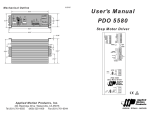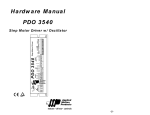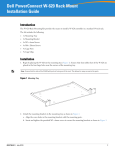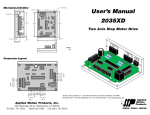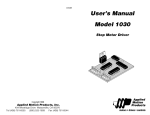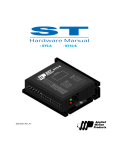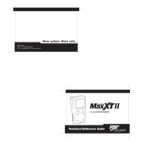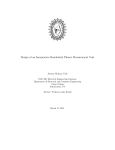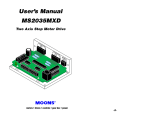Download User Manual
Transcript
4/18/96 User's Manual PD5580 Step Motor Driver DIR+ DIR– STEP+ STEP– EN+ EN– FAULT+ FAULT– POWER OVER TEMP OVER CURRENT 1 2 3 4 MICROSTEP RESOLUTION 1 2 3 4 5 6 7 50% IDLE 0.1 0.2 0.4 0.8 1.6 1.9 CURRENT (BASE = 0.5 A) AC POWER MOTOR PD5580 Step Motor Driver B– B+ A– A+ GND N L NEAR R E W PO 404 Westridge Drive Watsonville, CA 95076 Tel (408) 761-6555 (800) 525-1609 Fax (408) 761-6544 LY LI Applied Motion Products, Inc. SUPP motors • drives • controls Mechanical Outline 8.00 " DIR+ DIR– STEP+ STEP– EN+ EN– FAULT+ FAULT– POWER OVER TEMP OVER CURRENT 50% IDLE 0.1 0.2 0.4 0.8 1.6 1.9 5.45 " 1 2 3 4 5 6 7 5.30 " CURRENT (BASE = 0.5 A) MICROSTEP RESOLUTION 1 2 3 4 PD5580 Step Motor Driver B– B+ A– A+ GND L N -19-2- 0.25" 2.15" 1.25 " 3.00 " MOTOR AC POWER 3.07 " 8.97 " 9.25 " 0.06" 2.02 " Technical Specifications Amplifiers Dual, MOSFET H-bridge, 3 state, pulse width modulated switching at 20 kHz. 0.5 - 5.5 amps/phase output current, switch selectable in 0.1 increments. 400 watts maximum output power. Overcurrent and overtemperature protection. Automatic idle current reduction (defeatable), reduces current to 50% of setting after one second. Minimum motor inductance is 0.8 mH. Power Supply Linear, toroidal transformer based for high reliability and low noise. 110 or 220 VAC input, switch selectable. 60 Hz only (a 50 Hz version for overseas operation can be special ordered). 400 W max. DC voltage at nominal line voltage: 75 VDC full load, 90 VDC no load. Inputs Step, direction and enable, optically isolated, differential 5-12V logic. 5 mA mininum, 20 mA maximum input current. Motor steps on falling edge of step input. 1 µsec minimum pulse, 2 MHz max step rate. 1 µsec minimum set up time, 50µs minimum hold time for direction signal. Optically isolated, uncommitted (open collector, open emitter) photo transistor. 30V, 20 mA max. Physical Block Diagram 110/220 VAC step+ step– dir+ dir– enable+ enable– Power Amplifier 2 3 4 5 6 7 Isolation Fault Monitor overcurrent overtemp -3- 1 -18- +80V Microstep Sequencer fault lights fault+ fault– Power Supply Optical Isolation microstep resolution European style, pluggable screw terminal blocks. Motor: 4 position. Signal Input/output: 8 position. AC Input: 3 position. power light fuse 1 2 3 4 Connectors Constructed with black anodized aluminum heat sink and heavy gauge steel housing. 3 x 5.3 x 8 inches overall. 7.8 lbs. 70 C max. heat sink temperature. Power,overtemp and overcurrent LEDs. Mounting brackets and switch cover included. See back cover for detailed drawing . Features • Drives sizes 14 (1.4") through 42 (4.2") step motors • Built in 80 volt power supply (accepts 110 or 220 VAC power, 60 Hz only) • MOSFET pulse width modulation switching amplifiers (3 state) • Phase current from 0.5 to 5.5 amps/phase (switch selectable, 51 settings) • Step, direction, amplifier enable inputs, fault output, optically isolated • Microstepping from full step through 1/ 254 (switch selectable, 16 settings) • Overtemp and overcurrent (short circuit) and surge protection • Idle current reduction (50%, switch selectable) • pluggable screw terminal connectors motor current 50% idle on/off motor phase B Microstepping 16 switch selectable resolutions. Steps per revolution with 1.8 motor: 200, 400, 1000, 2000, 5000, 10000, 12800, 18000, 20000, 21600, 25000, 25400, 25600, 36000, 50000, 50800. Waveform: pure sine standard. Other waveforms available upon request. Thank you for selecting an Applied Motion Products motor control. We hope our dedication to performance, quality and economy will make your motion control project successful. If there's anything we can do to improve our products or help you use them better, please call or fax. We'd like to hear from you. Our phone number is (800) 525-1609 or you can reach us by fax at (408) 761–6544. motor phase A Fault Output Introduction Getting Started Recommended Motors To use your Applied Motion Products motor control, you will need the following: The following tables lists motors and current settings that are recommended for the PD5580 drive. ✔ a power cable (line cord) ✔ a source of step pulses capable of sourcing or sinking at least 5 mA ✔ if your application calls for bidirectional rotation, you'll also need a direction signal, capable of sourcing or sinking 5 mA ✔ a compatible step motor ✔ a small flat blade screwdriver for tightening the connectors - an Applied Motion Products screwdriver suitable for this purpose is included with your drive. ✔ if you want to power the drive from 220 volts, you'll need a Philips screwdriver to remove the cover The sketch below shows where to find the important connection and adjustment points. Please examine it now. All mating connectors are included. DIR+ DIR– STEP+ STEP– EN+ EN– FAULT+ FAULT– DIR STEP ENABLE FAULT OUT POWER LEDs OVER CURRENT switches 1 2 3 4 MICROSTEP RESOLUTION POWER OVER TEMP FAULT OVER CURRENT FAULT 1 2 3 4 5 6 7 50% IDLE 0.1 0.2 0.4 0.8 1.6 1.9 Winding Max Torque Connection oz-in parallel 75 parallel 120 parallel 177 parallel 185 parallel 300 parallel 390 parallel 595 logic connector OVER TEMP CURRENT (BASE = 0.5 A) Motor Number 5023-122 5023-123 5023-124 5034-348 5034-349 5034-350 5042-022 IDLE REDUCTION PHASE CURRENT switches AC POWER MOTOR MICROSTEP RESOLUTION B– B+ A– A+ connector GND connector N AC POWER MOTOR L -4- -17- Max Power Current Setting Watts Amps/phase 60 2.0 93 2.5 110 3.5 133 4.8 151 5.0 213 5.5 300 5.5 Fault Protection Connecting the AC Line The PD5580 provides protection against motor short circuits and excessive drive temperature. If the OVERTEMP light is on the PD5580 has detected a thermal problem and shut down the amplifiers. The first thing you should do is to unplug the drive from the power source. Next, touch the heat sink with your fingers. If it is very hot, the drive has probably overheated. Usually this means you need more air flow around the drive. If the OVERCURRENT light is on the PD5580 has detected a short circuit and has shut down the amplifiers. Unplug the drive from the power source. Check the motor wiring carefully. Make sure that the connections to the drive are secure and that any unused motor leads are insulated from the drive and power supply and from each other. Check the motor leads for shorts between phases or to ground. ! 110 Volts The PD5580 is set for 110 volt operation at the factory. All you need to do is install a power cord and plug it in. If you want to direct wire the PD5580 to AC power, you must consult a qualified electrician and observe all building and electrical codes. The AC cord you can install yourself, but be careful: AC power can be dangerous. 220 Volts The PD5580 is set for 110 volt operation at the factory. In order to use 220 volts, you'll need to change a switch setting inside the case. However, you can do this from the outside with your Applied Motion screwdriver. Mounting the Drive You can mount your drive on the wide or the narrow side of the case. Either way you'll need to get the brackets and screws out of the accessory bag and bolt them onto the PD5580. If you're mounting on the narrow side, you'll first have to remove one of the screws from the heat sink, then put it back with the bracket in place, as shown in the figure. Bracket position for wide side mounting. Place brackets on top and bottom of drive. Before you can change the 100/220 volt switch setting, you must remove the motor connector and the AC power connector from the drive. Set the drive on the widest side, so that the heat sink fins are pointing upward. Once you've done that, you'll see an opening in the case, just above the three position and four position green connectors. If you look into the slot, you should see two black objects. The one on the left is the fuse. The black object to the right of the fuse is the 110/220 volt switch. The sketches below and on page 6 show the two positions of the switch. To change from 110V to 220V, carefully insert your scredriver into the slot and push the switch to the right. AC POWER MOTOR B– B+ A– A+ L N ! Never use your drive in a space where there is no air flow or where the ambient temperature exceeds 50°C (120°F). Never block the fins of the heat sink or the vent holes. Never put the drive where it can get wet. Never allow metal particles near the drive. -16- GND This screw is already in the drive. ! Do not open the PD5580 case. Do not attempt to change the 110/220 volt switch setting until the power has been removed from the drive for at least five minutes. Unplug these connectors -5- PD5580 Step Motor Driver Bracket position for narrow side mounting. Place brackets on top and bottom of drive. If you plan to operate the PD5580 outside of North America, in a country where the powerline frequency may be less than 60 Hz, you must order the special 50 Hz version of the PD5580. B– B+ A– A+ GND N L B– B+ A– A+ N L GND Selecting Microstep Resolution 1 2 3 4 1 2 3 4 1 2 3 4 1 2 3 4 1 2 3 4 1 2 3 4 -15- 1 2 3 4 STEPS/REV (1/254) 1 2 3 4 50800 MICROSTEP RESOLUTION STEPS/REV (.02°) STEPS/REV (1/250) MICROSTEP RESOLUTION 18000 STEPS/REV (.01°) MICROSTEP RESOLUTION STEPS/REV (1/64) 50000 STEPS/REV (1/128) MICROSTEP RESOLUTION -6- 12800 STEPS/REV (1/127) MICROSTEP RESOLUTION Always unplug the line cord from the wall before attaching it ! to the PD5580 •Connect the black or brown wire to the PD5580 "L" terminal of the AC power connector. That is the line, or "hot" connection. •Connect the white or blue wire to neutral. That's the "N" terminal. •Finally, and most importantly, connect the green wire to the GND terminal. That connects the PD5580 metal enclosure and DC power supply ground to earth ground. STEPS/REV (1/50) 36000 STEPS/REV (1/125) MICROSTEP RESOLUTION "New Style" AC Power Plug 10000 STEPS/REV (1 arc min) MICROSTEP RESOLUTION black STEPS/REV (1/100) MICROSTEP RESOLUTION "Old Style" AC Power Plug To Neutral To Line (Hot) 1 2 3 4 To Line (Hot) 1 2 3 4 n green white To Earth Ground 25600 1 2 3 4 To Neutral 25400 1 2 3 4 To Earth Ground 1 2 3 4 o whit e r blue o black r brow 1 2 3 4 STEPS/REV (1/25) green 1 2 3 4 5000 1 2 3 4 2000 STEPS/REV (1/10) 25000 MICROSTEP RESOLUTION Make sure you follow the proper sketch your connector style. 1000 STEPS/REV (1/5) MICROSTEP RESOLUTION The AC power plug that was shipped with your PD5580 might be one of two types. The "old style" is shown below, on the left. The "new style" (shown on the right) comes with an insulating rubber boot. STEPS/REV (HALF) 21600 MICROSTEP RESOLUTION Installing an AC Line Cord Remove about 5 mm (3/16 inches) of insulation from each of the three wires of your line cord. (That's right, three wires. For safety, always use a three wire power cord on anything with a metal case.) Depending on where you got your power cord, it may have black, white and green wires or brown/blue/green. 400 MICROSTEP RESOLUTION switch in 220V position MICROSTEP RESOLUTION fuse switch in 110V position MICROSTEP RESOLUTION fuse 20000 MICROSTEP RESOLUTION STEPS/REV (FULL) MICROSTEP RESOLUTION 200 Idle Current Reduction Your drive is equipped with a feature that automatically reduces the motor current by 50% anytime the motor is not moving. This reduces drive heating by about 50% and lowers motor heating by 75%. This feature can be disabled if desired so that full current is maintained at all times. This is useful when a high holding torque is required. To minimize motor and drive heating we highly recommend that you use the idle current reduction feature unless your application strictly forbids it. Idle current reduction is enabled by sliding switch #1 toward the 50% IDLE label,as shown in the sketch below. Sliding the switch away from the 50% IDLE label disables the reduction feature. 1 1 Idle Current Reduction Selected Connecting the Motor ! Never connect the motor to the driver when the AC power is on. Secure any unused motor leads. Never disconnect the motor while the AC power is on. Never connect motor leads to ground or to a power supply. You must now decide how to connect your motor to the drive. A+ Four lead motors can only be connected one way. Please follow the sketch at the right. Red 4 lead motor A– Blue Yellow B+ No Current Reduction White B– 4 Leads Microstepping Most step motor drives offer a choice between full step and half step resolutions. In full step mode, both motor phases are used all the time. Half stepping divides each step into two smaller steps by alternating between both phases on and one phase on. Microstepping drives like the PD5580 precisely control the amount of current in each phase at each step position as a means of electronically subdividing the steps even further. The PD5580 offers a choice of full and half step as well as 14 other step resolutions. The highest setting divides each full step into 254 microsteps, providing 50,800 steps per revolution when using a 1.8° motor. Six lead motors can be connected in series or center tap. In series mode, motors produce more torque at low speeds, but cannot run as fast as in the center tap configuration. In series operation, the motor should be operated at 30% less than the rated current to prevent overheating. Winding diagrams for both connection methods are shown below. Note: NC means not connected to anything. A– In addition to providing precise positioning and smooth motion, microstep drives can be used for motion conversion between different units. The 25,400 step/rev setting is provided as a means of converting motion from metric to english. (There are 25.4 mm in an inch.) Other settings provide step angles that are decimal degrees (36,000 steps/rev makes the motor take 0.01° steps.) Some settings are used with lead screws. When the drive is set to 2000 steps/rev and used with a 5 pitch lead screw, you get .0001 inches/step. NC A+ Grn/Wht A– Grn/Wht 6 lead motor White Green A+ NC Red B– Red/ Wht Black NC Green Red B– B+ 6 Leads Series Connected -14- 6 lead motor White Red/ Wht Black B+ NC 6 Leads Center Tap Connected -7- The PD5580 drive contains optical isolation circuitry to prevent the electrical noise inherent in switching amplifiers from interfering with your circuits. A schematic diagram of the step input circuit is shown below. The DIRECTION and ENABLE circuits are the same as STEP. 680 0.1 3.8 0.2 0.4 AMPS/ 0.8 PHASE 1.6 1.9 0.1 4.4 0.2 0.4 AMPS/ 0.8 PHASE 1.6 1.9 0.1 4.9 0.2 0.4 AMPS/ 0.8 PHASE 1.6 1.9 0.1 5.0 0.2 0.4 AMPS/ 0.8 PHASE 1.6 1.9 PD5580 Input Circuit Your logic signals can be sourcing, sinking or both (differential). The input current will be about 1 mA per volt. Thus, if your logic signals are 5 volts, you'll be putting -8- -13- 2 3 4 5 6 7 Connecting Logic 0.1 4.3 0.2 0.4 AMPS/ 0.8 PHASE 1.6 1.9 2 3 4 5 6 7 Step 2 is the Power Up State 0.1 3.7 0.2 0.4 AMPS/ 0.8 PHASE 1.6 1.9 2 3 4 5 6 7 DIR=0 ccw 2 3 4 5 6 7 B– + + – – 2 3 4 5 6 7 B+ + – – + + 0.1 5.4 0.2 0.4 AMPS/ 0.8 PHASE 1.6 1.9 0.1 5.5 0.2 0.4 AMPS/ 0.8 PHASE 1.6 1.9 2 3 4 5 6 7 A– – + + – 0.1 4.8 0.2 0.4 AMPS/ 0.8 PHASE 1.6 1.9 2 3 4 5 6 7 A+ + + – – + 0.1 4.2 0.2 0.4 AMPS/ 0.8 PHASE 1.6 1.9 0.1 5.3 0.2 0.4 AMPS/ 0.8 PHASE 1.6 1.9 2 3 4 5 6 7 DIR=1 cw Step 0 1 2 3 4 0.1 3.6 0.2 0.4 AMPS/ 0.8 PHASE 1.6 1.9 0.1 5.2 0.2 0.4 AMPS/ 0.8 PHASE 1.6 1.9 2 3 4 5 6 7 Step Table (full stepping) 0.1 5.1 0.2 0.4 AMPS/ 0.8 PHASE 1.6 1.9 2 3 4 5 6 7 8 Leads Parallel Connected 2 3 4 5 6 7 8 Leads Series Connected Red/Wht B– 0.1 4.7 0.2 0.4 AMPS/ 0.8 PHASE 1.6 1.9 2 3 4 5 6 7 Yel/ B+ Wht 0.1 4.1 0.2 0.4 AMPS/ 0.8 PHASE 1.6 1.9 2 3 4 5 6 7 Yel/ Wht B– 0.1 3.5 0.2 0.4 AMPS/ 0.8 PHASE 1.6 1.9 2 3 4 5 6 7 Yellow 0.1 4.6 0.2 0.4 AMPS/ 0.8 PHASE 1.6 1.9 2 3 4 5 6 7 B+ Red/ Wht Yel low 0.1 4.5 0.2 0.4 AMPS/ 0.8 PHASE 1.6 1.9 2 3 4 5 6 7 Red Black Red 2 3 4 5 6 7 Black 0.1 4.0 0.2 0.4 AMPS/ 0.8 PHASE 1.6 1.9 2 3 4 5 6 7 Org/ Wht A– 0.1 3.4 0.2 0.4 AMPS/ 0.8 PHASE 1.6 1.9 8 lead motor 2 3 4 5 6 7 Blk/Wht A– Blk/Wht 8 lead motor Org/Wht Orange 2 3 4 5 6 7 A+ 0.1 3.9 0.2 0.4 AMPS/ 0.8 PHASE 1.6 1.9 2 3 4 5 6 7 Orange 0.1 3.3 0.2 0.4 AMPS/ 0.8 PHASE 1.6 1.9 2 3 4 5 6 7 A+ Current Setting Table, Part 2 (3.3 - 5.5 amps/phase) 2 3 4 5 6 7 Eight lead motors can also be connected in two ways: series and parallel. As with six lead motors, series operation gives you more torque at low speeds and less torque at high speeds. In series operation, the motor should be operated at 30% less than the rated current to prevent overheating. The wiring diagrams for eight lead motors are shown below. 5 mA through the optocouplers. For 12 volt logic, the current is 12 mA. Current Setting Table, Part 1 (0.5 - 3.2 amps/phase) 2 3 4 5 6 7 2 3 4 5 6 7 2 3 4 5 6 7 0.1 3.2 0.2 0.4 AMPS/ 0.8 PHASE 1.6 1.9 2 3 4 5 6 7 2 3 4 5 6 7 2 3 4 5 6 7 2 3 4 5 6 7 -12- 0.1 3.1 0.2 0.4 AMPS/ 0.8 PHASE 1.6 1.9 2 3 4 5 6 7 2 3 4 5 6 7 0.1 2.5 0.2 0.4 AMPS/ 0.8 PHASE 1.6 1.9 0.1 3.0 0.2 0.4 AMPS/ 0.8 PHASE 1.6 1.9 2 3 4 5 6 7 2 3 4 5 6 7 0.1 2.4 0.2 0.4 AMPS/ 0.8 PHASE 1.6 1.9 0.1 2.9 0.2 0.4 AMPS/ 0.8 PHASE 1.6 1.9 2 3 4 5 6 7 2 3 4 5 6 7 0.1 2.3 0.2 0.4 AMPS/ 0.8 PHASE 1.6 1.9 0.1 2.8 0.2 0.4 AMPS/ 0.8 PHASE 1.6 1.9 2 3 4 5 6 7 2 3 4 5 6 7 0.1 2.2 0.2 0.4 AMPS/ 0.8 PHASE 1.6 1.9 0.1 2.7 0.2 0.4 AMPS/ 0.8 PHASE 1.6 1.9 2 3 4 5 6 7 2 3 4 5 6 7 0.1 2.1 0.2 0.4 AMPS/ 0.8 PHASE 1.6 1.9 0.1 2.6 0.2 0.4 AMPS/ 0.8 PHASE 1.6 1.9 2 3 4 5 6 7 0.1 2.0 0.2 0.4 AMPS/ 0.8 PHASE 1.6 1.9 2 3 4 5 6 7 0.1 1.9 0.2 0.4 AMPS/ 0.8 PHASE 1.6 1.9 2 3 4 5 6 7 0.1 1.8 0.2 0.4 AMPS/ 0.8 PHASE 1.6 1.9 2 3 4 5 6 7 0.1 1.7 0.2 0.4 AMPS/ 0.8 PHASE 1.6 1.9 2 3 4 5 6 7 0.1 1.1 0.2 0.4 AMPS/ 0.8 PHASE 1.6 1.9 0.1 1.6 0.2 0.4 AMPS/ 0.8 PHASE 1.6 1.9 2 3 4 5 6 7 0.1 1.0 0.2 0.4 AMPS/ 0.8 PHASE 1.6 1.9 0.1 1.5 0.2 0.4 AMPS/ 0.8 PHASE 1.6 1.9 2 3 4 5 6 7 0.1 0.9 0.2 0.4 AMPS/ 0.8 PHASE 1.6 1.9 0.1 1.4 0.2 0.4 AMPS/ 0.8 PHASE 1.6 1.9 2 3 4 5 6 7 0.1 0.8 0.2 0.4 AMPS/ 0.8 PHASE 1.6 1.9 0.1 1.3 0.2 0.4 AMPS/ 0.8 PHASE 1.6 1.9 2 3 4 5 6 7 0.1 0.7 0.2 0.4 AMPS/ 0.8 PHASE 1.6 1.9 0.1 1.2 0.2 0.4 AMPS/ 0.8 PHASE 1.6 1.9 2 3 4 5 6 7 0.1 0.6 0.2 0.4 AMPS/ 0.8 PHASE 1.6 1.9 2 3 4 5 6 7 0.1 0.5 0.2 0.4 AMPS/ 0.8 PHASE 1.6 1.9 Logic low, or 0, for a given input occurs when the + and – signal pins have at least 4 volts DC across them. In this state the LED is conducting current. Logic high, or 1, occurs when the + and – inputs are less than 1 volt apart, or open. STEP tells the driver when to move the motor one step. The drive steps on the falling edge of the pulse. The minimum width is 1 microsecond. DIRECTION signals which way the motor should turn. See the step table on page 7 for details. The DIRECTION signal should be changed at least 1 microsecond before a step pulse is sent and held for at least 50 µsec after the step pulse is sent. If you change the state of the direction input and send a step pulse at the same instant the motor may take a step in the wrong direction. ENABLE allows the user to turn off the current to the motor by setting this signal to logic 0. The logic circuitry continues to operate, so the drive "remembers" the step position even when the amplifiers are disabled. However, the motor may move slightly when the current is removed depending on the exact motor and load characteristics. If you have no need to disable the amplifiers, you don't need to connect anything to the ENABLE input. Differential Logic If your controller has STEP+, STEP-, DIR+ and DIR- outputs, which many indexers do, the connections are simple. Just connect STEP+ to STEP+, STEP- to STEP- and so forth, as shown below. Indexer or Controller with Differential Outputs DIR+ DIR+ DIR- DIR- STEP+ STEP+ STEP- STEP- ENABLE+ ENABLE+ ENABLE- ENABLE- = optional signal -9- PD5580 Drive Sinking Logic If your controller has STEP, DIR and +5V outputs, like the Applied Motion Products SI-1 indexer, connect STEP+ and DIR+ to +5V. Connect STEP- to STEP. Connect DIR- to DIR. Indexer or Controller with Sinking Outputs +5V OUT DIR+ DIR DIRSTEP+ STEP STEP- PD5580 Drive The PD5580 has a fault output to tell you if the drive has overheated or if a short circuit has occured at the motor outputs. The fault output is optically isolated for noise immunity. This makes it more flexible and more reliable, but also harder to hook up. To connect to 5 volt logic, follow the sketch below. For other connections, consult the factory. The photo transistor turns on when there is a fault. In circuit below, the signal will be high (near 5 volts) when there is no fault. The signal will go low (0 volts) if a fault occurs. PD5580 ENABLE+ ENABLE- ENABLE- TTL or CMOS input Sourcing Logic If your controller has STEP, DIR and GND (ground or common) outputs, connect STEP- and DIR- to GND. Connect STEP+ to STEP. Connect DIR+ to DIR. DIR DIRSTEP+ STEPENABLE ENABLE+ GROUND ENABLE- PD5580 Drive = optional signal The PD5580 optical isolation circuits have built in resistors for 5 - 12 volt logic. If your logic voltage is greater than 12 volts but no more than 24 volts, you can add series resistors to the signal "+" pins (i.e. STEP+, DIR+, etc). Use 1/4 watt, 1000 ohms. Current Setting Formula Locate the bank of eight switches. Six of the switches have a value of current printed next to them, such as 0.1 and 1.6. Each switch controls the amount of current, in amperes (A), that it's label indicates. There is always a base current of 0.5 A. To add to that, slide the appropriate switches toward their labels. You may need your small screwdriver for this. Example Suppose you want to set the driver for 4 amps per phase. You need the 0.5 A base CURRENT current plus another 1.6 and 1.9 A. (BASE=0.5A) 4.0 (TOTAL) = 0.5 (BASE) + 1.6 + 1.9 Slide the 1.6 and 1.9 A switches toward the labels as shown in the figure. -11- 0.1 0.2 0.4 0.8 1.6 1.9 2 3 4 5 6 7 If Your Logic Voltage is not 5 to 12 Volts -10- Setting Phase Current Before you turn on the power supply the first time, you need to set the driver for the proper motor phase current. The rated current is usually printed on the motor label. The current you set on the PD5580 is the peak current, not RMS. The PD5580 drive current is easy to set. If you wish, you can learn a simple formula for setting current and never need the manual again. Or you can skip to the table on the next page, find the current setting you want, and set the DIP switches according to the picture. DIR+ STEP +5 VDC Resistor 10k 1/4W 1k = optional signal Indexer or Controller with Sourcing Outputs Using the Fault Output










